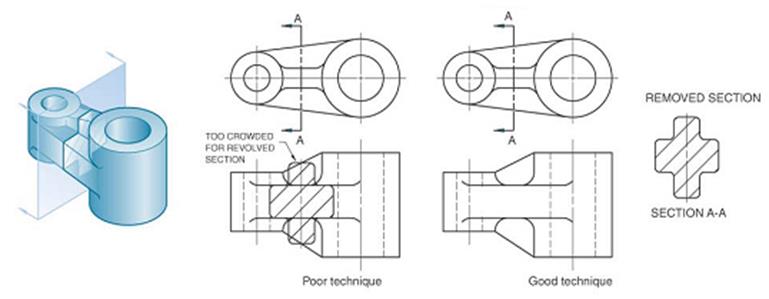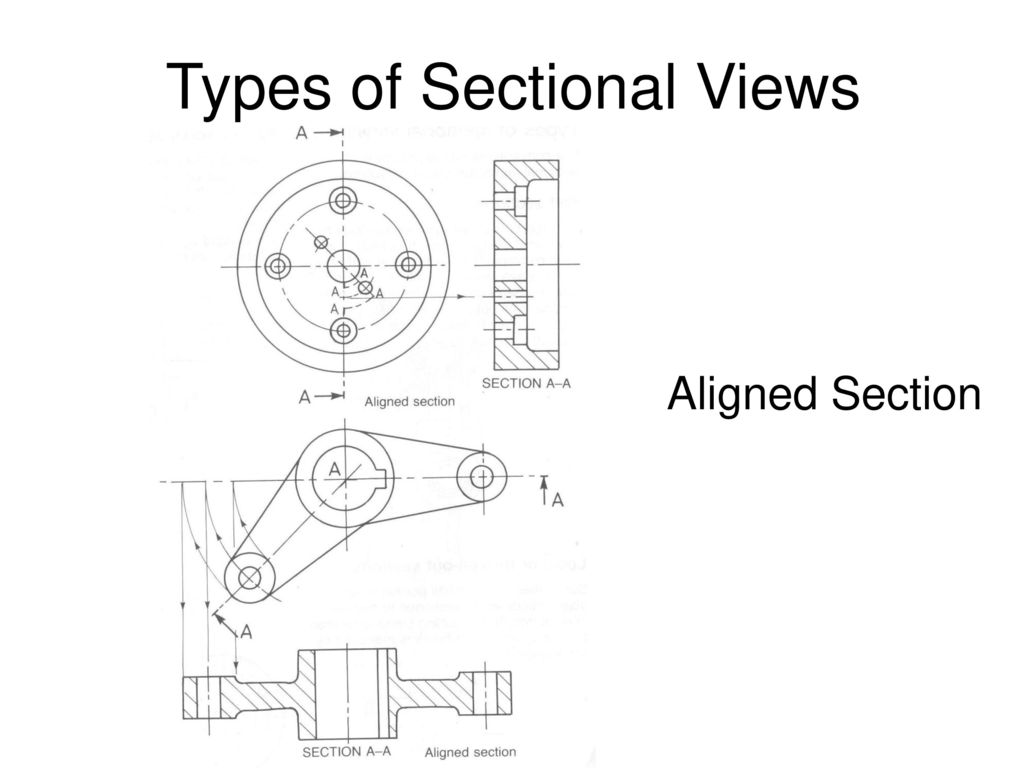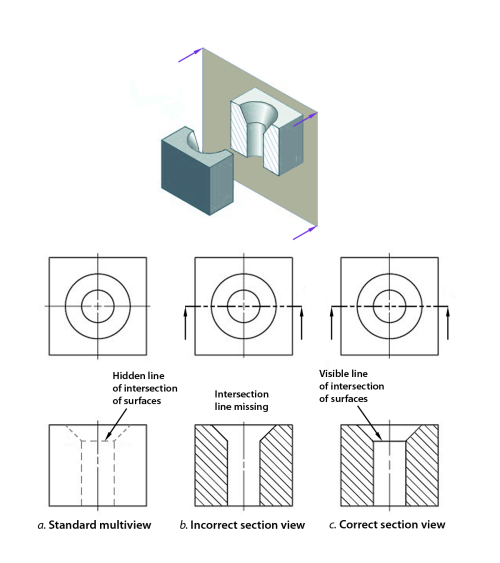Full section The view obtained even the cutting plane is right across the object. A simple bracket is shown in Fig.

Sectional Views In Engineering Technical Drawings
Features that cannot be seen by hidden detail Cutting plane removes part section is what is left Cross hatching ois at 45 equispaced Centrelines often used for cutting planes Very thin sections not hatched eg.

. Placement of a cross-section view 31. Section Callout or Blow Up Section. Plan Section Elevation Drawings.
Full sections half sections broken sections rotated. The lines are thin and are usually drawn. BROKEN-OUT SECTION VIEW A break line is used to separate the sectioned portion from the unsectioned portion of the view.
6 Types of sectional views Full sections. Here is an object sectioned from two different directions. This is the most common section called a full section with the imaginary laser cutting a line across.
Half sections are commonly used to show both the internal and outside view of symmetrical objects. A single view of an object is rarely adequate to show all necessary features. A cutting plane line shows where object was cut to obtain the section view.
Break from orthographic view. An elevation drawing is a view taken from a point outside the object without any slicing. A section drawing is a view taken after you slice an object then look at the surface created by the slicing.
In this type of section only half of the space or object is cut away. What is Half Section. There are three major types of sections used in engineering drawing.
Copyright 2006 by K. Sectioning and Types of Sections Dr-Ing. These lines are called section lining or cross-hatching.
You have learned that when making a multiview sketch hidden edges and surfaces are usually shown with hidden dash lines. This means they are not drawn in perspective and there is no foreshortening. Haitem Hichri Section Views What is a section view.
81 and it is required to draw three sectional viewsAssume that you had a bracket and cut it with a hacksaw along the line marked B-B. Sectioning and Types of Sections for Students. Concept example A section view is made by revolving the cross-section view 90 o about a cutting plane line and drawn on the orthographic view.
Section lines are evenly. Example a a b b 30. Half sections or views.
A half-section is a view of an object showing one-half of the view in section as in figure 19 and 20. Common types of orthographic drawings include plans elevations and sections. Full View Shows the entire model.
Engineering drawing views engineering drawing types INTRODUCTION. Sectional views are used in technical drawing to expose internal surfaces. They serve to present additional orthographic views of surfaces.
Mechanical Engineering Drawing and Graphics Lecture 1. Partial or Broken Out Section 4. There are a number of different types of sectional views that can be drawn.
The line that separates the different types interior and exterior may be a. Sectional views in engineering technical drawings Half Sectional views. A section is used to show the detail of a component or an assembly on a particular plane which is known as the cutting plane.
Half Section is used to the exterior and interior of the part in the same view. Partial View Shows only the portion of the view that is contained within a boundary. - इजनयरग डरइग म सकशन क परकर 1.
The cutting-plane line cuts halfway through the part and removes one quarter of the material. Engineering Graphics with AutoCAD 2011 1e James Bethune. There are three major types of sections used in engineering drawing.
When specific features of an object that need highlighting are not located. Normally a view is replaced with the full section view. There are different types of section drawings.
32 Types of Sections 324 Aligned section 325 Rib and web sections 326 Broken section 327 Removed section 328 Revolved section 329 Non-sectioned parts 3210 Thin sections. Section Views Yes Section views convention Finish Dr. K half section The view Obtained When the cutting plane goes half way across the Object to the centre line.
Engineering drawings are often referred to as Blueprints. Figure 19 - Full and sectioned isometric views. Superimposed to orthographic view.
Figure 53 is an example of orthographic projection showing the six principal views used by architects and engineers in construction and industrial drawings. Types of Sectional Views Full Section. In this view the cutting plane is assumed to bend at a right angle and cuts through only half of the.
Full section in a full section the cutting plane line passes fully through the part. Half View Shows only the portion of the model on one side of a datum plane. Gaskets seals Do not show hidden detail in sectional view.
What is Full Section. Types of Views in Engineering Drawing. In both cases the object should be standing on its base when the.
A short series of lectures on Engineering Drawing as Part of ENGG1960 By Paul Briozzo. Reflected Ceiling Plan or RCP. Section drawings are orthographic projections with the exception of section perspectives.
No need for additional orthographic views. Broken View Removes sections from large objects between two points and moves the remaining sections close together. REVOLVED SECTION VIEW Revolved sections show cross-sectional features of a part.
A full section is the most widely-used sectional view. A cutting plane does not necessarily need to cut the whole object. A revolving view is effective for elongated objects or.
There is no cutting plane line. However the terms are becoming an anachronism since most copies of engineering drawings that were made using a chemical-printing process that yielded graphics on blue-coloured paper. Figure 20 - Front view and half section.
Break line is a thin continuous line and is drawn freehand. Types of Section in Engineering Drawing. Section lines are used to define areas that represent where solid material has been cut in a sectional view.
Revolved section. A few of the more common ones are. The diagonal lines on the section drawing are used to indicate the area that has been theoretically cut.

Sectioning Technique Engineering Design Mcgill University



0 comments
Post a Comment